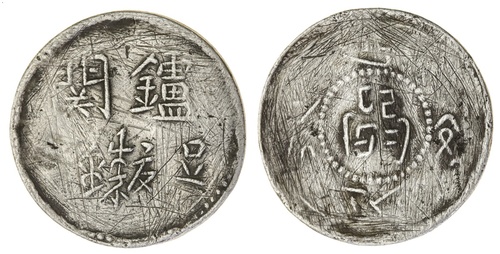
Auction: CSS45 - Banknotes, Bonds & Shares and Coins of China and Hong Kong
Lot: 195
China for Tibet, Anonymous (c.1902-3), 'Lukuan' (lu guan) Rupee, 11.34g, undated (YZM 438; KM Y#A1.1; LM 655), harshly cleaned, fine, one of the key Tibetan coins, extremely rare in any condition
According to the obverse inscription, this rare coin is known as Lukuan (lu guan) Rupee.
It was struck in the Kangding mint in western Sichuan. This Rupee can be considered as the forerunner of the Sichuan Rupee. It is believed that in 1902AD "Liu Ding Shu", Sub-Prefect of Ta Chien Lu (now Kangding district) ordered the minting of "Lu Guang" silver coins in order to eliminate the circulation of foreign coins, particularly of British-Indian Rupees, in Szechuan Province. Liu used the silver being transported to Tibet for military expenses to mint the coin (http://ykleungn.tripod.com/szeRupee.htm).
Nicholas Rhodes (Rhodes, Nicholas: "A Sino-Tibetan Rupee". Spink's Numismatic Circular, vol. 85, London, 1977, pp.107-108) has attempted to read the legends as follows: Obverse legend (to be read from right to left): "Lu guan tsu yin ?" ("Tachienlu Customs enough silver"). The syllable "lu" could be interpreted as the last syllable of Da jian lu, the
former Chinese name of Kangding, from which the Western version "Tachienlu" is derived. The webpage zeno.ru suggests the following transscription in Pinyin and translation of the Chinese legend: ???? (????) [lú gu?n zú yín], where ?? [zú yín] translates as 'pure (or fine) silver' (https://www.zeno.ru/showphoto.php?photo=131532).
The reverse Tibetan legend can be read as: nged gsum zho dar ("three sho of Tachienlu enough silver"). The syllable dar may be understood as being the first syllable of Dar rtse mdo, the traditional Tibetan name of present day Kangding, (LM-655, Y-A1.1).
The coin is genuine and was not graded because of condition. Both Chinese and Tibetan legends are fully legible.
Ex. Wolfgang Bertsch collection
Sold for
HK$35,000




